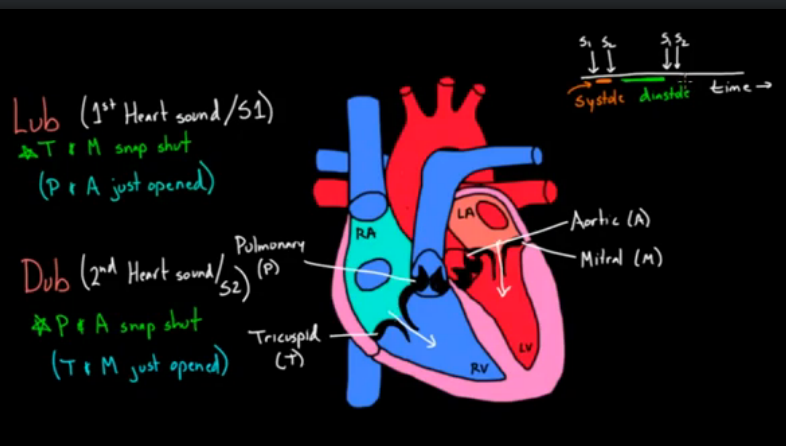And now you have white arrows going this way.
现在血液流动方向是这样
And we've returned to where we started from.
现在又重新回到了开始的状态
So you basically have a full cycle,
这样完成了一个工作周期
and between these two-- so let's say from lub to dub,
而从“咚”到“哒”
because there's a little bit of space there.
中间也是有一段时间的
If you were to follow it over time, over time,
如果我们一直观察的话
this is what it might look like if this is a little timeline.
我们在时间轴上画一下
You might hear lub here, or the first heart sound.
这是第一个心音 “咚”
I'll just call it S1.
记为S1
And you might hear S2 here, the second heart sound.
这里可能是S2

And then you'll hear S1 again over here and S2.
之后就是S1和S2的重复
And what's happening between the two-- so between these two,
而两者之间的空隙
this time lag here-- is that blood is actually squeezing out,
这段时间
because the pulmonary and aortic valves just opened.
是肺动脉瓣和主动脉瓣打开时
It is squeezing out and going out to the whole body.
血液送到身体各处的时间
So this is when blood is going to the body, and sometimes we call that systole.
这时血液被送到身体各处,这是心脏收缩期
And between dub and the next lub--
而在第二个心音和下一个周期的第一个心音之间
so in this area right here-- well, at that point,
也就是这段时间
blood is kind of refilling from the atriums into the ventricles, and we call that diastole.
血液从心房进入心室,这是心脏的舒张期
So now you can actually listen to your heart.
大家可以听一下自己的心跳
And you can actually figure out, well,
就能知道
if you're listening to the sound between lub and dub or the space in time between lub and dub,
在“咚”“哒”之间这段时间
that's when you're having systole.
是心脏的收缩期
And if you're listening to or waiting for the sound to start up again- so you just heard dub,
而如果听完“哒”在等“咚”的这个间隙中
and you're waiting for lub again--then that space in time is diastole.
这是心脏的舒张期












